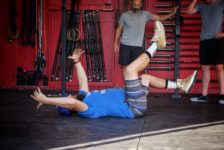
Our continual commitment to understand performance has us diving into persistent questioning and challenging of common practices. The latest under fire has specifically been the idea of the sit up as a purposeful exercise to develop a functioning trunk (or not). While we’ve never taken a surface-level position on the topic, our desire to go deeper is yielding progressive views that often run counter to socialized norms.
Legendary performance mind, Dr. Mel Siff, has had the following view for more than two decades:
“Even many physical therapists believe this advice, because it is maintained that abdominal strength necessarily enhances trunk stability. While the abdominals (recti abdominis) do contribute statically to trunk and pelvis stabilization during many activities, it is contraction of the major back muscles (erector spinae) which plays the dominant role in controlling erectness of the trunk.
The abdominal muscles statically resist the tendency of the abdomen to bulge excessively when the Valsalva (breath-holding) manoeuvre is used during heavy lifting, powerful stabilizing or pushing, and this is how they play a major role in contributing to trunk stability and so-called “core strength.” They assist in maintaining the intra-abdominal pressure to serve as a type of pneumatic cushion or corset for the spine during lifting or heavy resistance work. However, the strongest abdominals in the universe will not keep your back ‘straight’ during a heavy lift.
In fact, the more strongly your abdominals are pulled in, the less stable your trunk can be during lifting, so, if you are lifting any serious loads, you would be well advised to allow your body to do what it does naturally when it has to stabilize itself under any large or sudden loading – and that is to hold breath briefly and allow the abs to tense or distend slightly without any deliberate attempt to change anything during any dynamic movement. This is what the world’s strongest weightlifters have been doing safely and powerfully for many decades, so why not take a page out of the books of the world’s finest practical experts?
The most important fact of all is that the abdominal and oblique muscles play no dynamically active role in protecting the back, especially if one’s breath is not held. It is the deeper lying transversus muscle (which is not exercised by sit-ups or crunches!) which contracts first in response to breath-holding and straining during lifting and spinal extension. All of the other abdominal muscles serve to flex the trunk forwards, not keep the trunk erect, so it is illogical to believe that free-breathing abdominal exercise without adequate back (and side) strengthening exercises enhances trunk stability and prevents back pain or disability. 
In other words, much of the advice that you hear on protecting your back by executing more sit-ups or “pulling in” your abs, is often the opposite of what you should be doing. To protect your back, you strengthen the muscles of the back, not the front alone! Moreover, doing thousands of sit-ups or crunches will do little to strengthen your abdominals after the first few weeks of novice training. High repetition training with no progressive increase in load develops muscle endurance and some muscle bulk, but not great amounts of strength.
Far greater abdominal strength is developed statically and quite incidentally by automatic stabilizing actions taking place during many resistance training exercises such as squats, cable press-downs, power cleans, bench press, all forms of pressing and lat pull-downs. So, why on earth does everyone from aerobics fans to footballers believe that high repetition unloaded sit-ups really strengthen the abdominals? It is extremely rare to find anyone doing several sets of sit-ups or crunches using heavy loads for a few repetitions, yet this is precisely the type of training that one needs for developing abdominal strength, as opposed to abdominal endurance under light loading.
Most of us have already learned one of the basic principles of all training, namely that of Gradual Progressive Overload, which tells us if you wish to increase strength, then you gradually need to increase the load that you are training with. On the other hand, if you wish to increase muscle endurance, then you will try to increase the number of reps that you are doing.
This criticism of sit-ups and crunches is not meant to imply that abdominal strengthening is redundant. On the contrary, it is important to strengthen all of the front, back and side trunk muscles so that none of them exhibits a strength deficit during ‘functional’ or daily activities. More important than that is learning the correct techniques of lifting or overcoming heavy loads, since efficiency of movement and prevention of injury depends more on correctness of technique than on strength of individual muscle groups alone.
If certain muscles of the trunk, such as transversus abdominis and erector spinae, come into action in incorrect patterns or with inappropriate timing, then even enormous strength of these muscles will not insure you against injury.
It is just that conventional high repetition sit-ups and crunches generally are not very effective for developing strength of the abdominal musculature.
Not only are there superior ways of performing trunk flexion which really strengthen ‘the abs’, but in any extensive resistance training workout involving squats, tricep pushdowns, bent-arm pullovers, standing presses, cable crunches and bench press, the abdominal muscles receive highly very adequate strengthening, anyway.”
If you’ve made it this far, congratulations: you’re highly motivated and curious. You’re likely seeing more and more emphasis on intra-abdominal pressure around DEUCE, specifically surrounding bracing drills, dead bug variations, and postural work. This is why.
Logan Gelbrich
@functionalcoach
10/22/17 WOD
2-2-2-2-2
Box Squat
3x 10 Bulgarian Split Squat (Ea)
3x 20 Banded Good Mornings
Then, complete 4 rounds for time of:
400m Run
-Rest 1 min-

